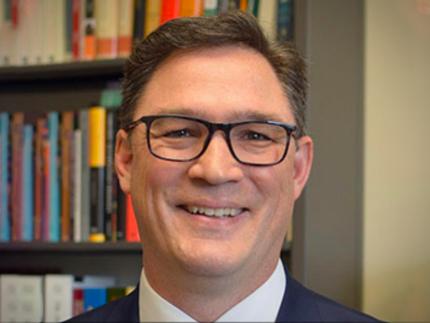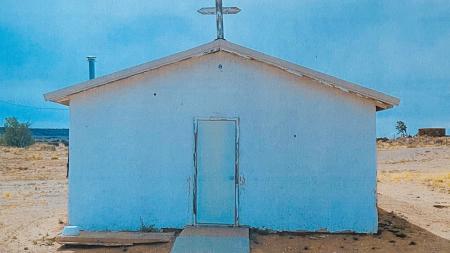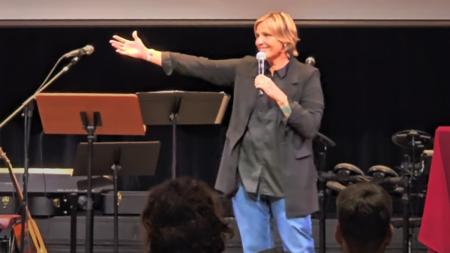Are the Liberal Arts Relevant?

In his Jan. 18 presentation at this year’s January Series, Dr. Noah Toly, chief academic officer at Calvin University, discussed liberal arts education and how it equips students to respond to the challenges and opportunities of our times.
In a nod to the lecture series itself, Toly noted that the January Series is an initiative that corresponds to some of the richness and mission of a liberal arts education by bringing in leading scholars, activists, practitioners, and public intellectuals to shed light on some of the world’s most pressing and complex issues.
“It reflects our identity as a Christian liberal arts university, a community committed to living and learning together, and one that defies the most unfortunate and inaccurate stereotypes of liberal arts education,” stated Toly.
He added, “It reflects our commitment to a model of higher education that is theologically grounded, even ecclesiastically grounded in our case, and intellectually intrepid – one that is deeply rooted in Reformed Christian thought, unabashedly relevant to the most pressing challenges and issues of the day, and unreservedly reaching out to the rest of the world. My talk today is a celebration of that particular brand of liberal arts education.”
Toly is involved in the Liberating Arts Project – conceived by seven colleagues at various institutions of higher education, including Calvin. Funded by a grant from the Council for Christian Colleges and Universities, the project began in 2020 as “Between Pandemic and Protest: Exploring the Future of the Liberal Arts in Higher Education” partly in response to polarization and challenges related to the COVID-19 pandemic, to the murder of George Floyd, and to growing calls for justice in many areas of society.
The members of the group, said Toly, shared an interest in liberal arts education and the institutions that provide it, questions and perceptions about the liberal arts, and the practical ways a liberal arts education could relate to the challenges and opportunities of the moment they were in.
In phase one of the project, the group invited others into the work and recorded dozens of hours of video podcast interviews to learn more about the questions and answers that stakeholders both inside and outside higher education had about liberal arts.
Now in phase two, the group is compiling a book in which more than 20 authors share insights and perspectives on the liberal arts, addressing questions that help us better understand the state and future of liberal arts education. Some of the common questions, said Toly, are, “Aren’t the liberal arts outdated? Elitist? Racist? A luxury good? Unprofitable? Liberal?” Toly asserted that the answer to all of these questions is “No.”
He continued, “Like a January Series line-up, the book has quite the list of contributors – including Calvin’s own Sean Sword, a student who began his studies in the Calvin Prison Initiative at Handlon Correctional Facility [in Ionia, Mich.,] and now continues them on Calvin’s Grand Rapids campus. His contribution gives his own unique perspective on the question ‘Aren’t the liberal arts a waste of time?’”
While Toly admitted that “liberal arts” can be difficult to define and that there is disagreement among people in higher education about what it includes, he said there are common practices and goals that bring together and harmonize logic and rhetoric, contemplation and action, vocational and nonvocational learning and orientation.
Borrowing from Richard A. Detweiler’s 2021 book, The Evidence Liberal Arts Needs: Lives of Consequence, Inquiry, and Accomplishment, Toly noted hoped-for outcomes of altruism, cultural engagement, civic engagement, success, leadership, and lifelong learning in students.
Working toward this goal, providers of a liberal arts education tend to have consistency in certain practices such as a broad scope of study; authentic community; proximity to people whose perspectives differ from your own; systematic engagement with nonprofessional fields of study; and engagement of questions of meaning, significance, and ethics, even in technical upper divisions of coursework.
Toly noted that something that liberal arts institutions often struggle with is a sense that the broader public doesn’t take for granted the value of a liberal arts education. Employers, community organizers, politicians, public health leaders, and others sometimes see a liberal arts education as disconnected from the needs found in the world around them. Many ask, “Aren’t the liberal arts irrelevant?”
The question shouldn’t surprise us, said Toly. We should expect students to come wanting an education that’s relevant. They should wonder whether the education they get will help them address problems and opportunities alike: from mass incarceration, climate change, war, and poverty to artificial intelligence, urban infrastructure, and energy breakthroughs.
“From ‘pandemics to protests’ students aren’t only interested because those are in the headlines but because the ability to wisely and redemptively respond to such issues is precisely what we’ve promised,” noted Toly.
He added, “Those promises aren’t a new twist. They’re not a recent invention, a desperate response to the market. . . . No, those promises are part of our DNA. The liberal arts have always promised relevance. The earliest known forms of liberal arts education were meant to prepare students for public responsibilities related to the pursuit of human flourishing and the common good.”
Toly suggested that sometimes when we defend liberal arts, we tend to oversimplify it. When we meet detractors, we resort to trite or tired defenses: a variety of skills, ready for anything – but Toly noted that the value of a liberal arts education is not merely that it equips students with adaptable skills suitable to a variety of work types, or that it prepares them for a succession of jobs they may hold during their life after university.
“If vocational open-endedness is the most that advocates can claim for a liberal arts education, then it might be a lost cause. The good news is there is so much more to say,” said Toly.
“A liberal arts education awakens students to a deeper, richer sense of relevance. It invites students not to abandon relevance, but to reappraise what counts as relevant. The liberal arts open us up to surprising insights and unanticipated connections and help us see that relevance is not only about what we know but about who we are,” asserted Toly.
Reflecting on how this awakening is accomplished, Toly listed four features of a relevant liberal arts education:
- It teaches us to grasp the ecosystem of knowledge. Liberal arts can’t be reduced to the breadth of the curriculum, but it also can’t be limited to a singular focus on any area of study. The liberal arts help us to understand an array of subjects, disciplines, and ways of knowing. The point of this scope isn’t to understand varied fields of study or their major points – but how they relate to each other. We can see connections within the world and act in creative ways in response.
- It teaches us to draw from the deepest wells. Liberal arts remind students that as they face challenges and opportunities, “addressing them does not require us to make our own beginning.” The wisdom of past learning and experience can apply to the latest headlines and the most complex problems of our time, said Toly. “There is no opportunity to make and do that cannot be shaped by better understanding the consequences of our inventions. There is no effort at sustainability and conservation that cannot be informed by the long history of wrestling with our own limits. There is no struggle for emancipation or justice that cannot be informed by thousands of years of thought about what it means to be human.”
- It teaches us to invest in asking questions before reaching answers. A liberal arts education prepares us to ask and to frame good questions and to be wary of beginning with answers in mind. Toly noted, “When we think we know the answers before we set out the questions, we risk doing the work of the greatest irrelevance – solutions to problems never posed. . . . A liberal arts education teaches students the disposition, skills, and humility to formulate and refine better questions, questions in service of more relevant answers.”
- At its best, it’s not only informative but also formative. A liberal arts education, suggested Toly, doesn’t just fill our heads with knowledge, but it also shapes our whole person. Through practices of attention, making, doing, and learning in a variety of areas among a variety of colearners, students are shaped and equipped, regardless of the vocations to which they may eventually be called.
A liberal arts education is not the only place where one can be so shaped, and it doesn’t have guaranteed or uniform effects, acknowledged Toly. But “it is an education that prepares us to be the kinds of people who address the challenges and opportunities of the moment, people with daring and disciplined imaginations necessary to fulfill even the most ambitious and relevant missions.”


